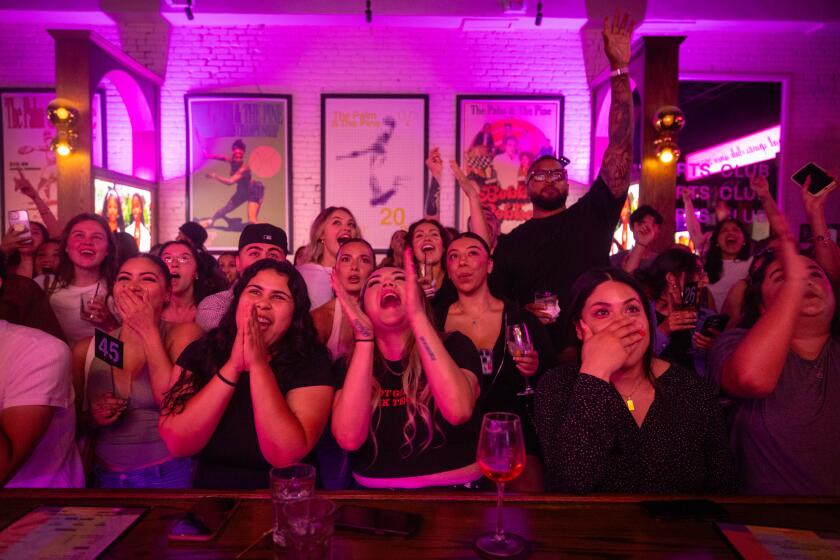Marvels of the Modern Age
- Share via
Offering a design overview of the 20th century from early Craftsman to Pop Art, the 11th annual L.A. Modernism Show is expected to attract thousands of visitors to the Santa Monica Civic Auditorium on Saturday and May 10.
More than 75 dealers, from throughout the United States and a sprinkling of international galleries, will be selling a wide array of furniture, pottery, jewelry, posters, radios, TVs and other large and small objects.
As the millennium draws to a close, interest in nostalgia is growing, said Elizabeth Lees, who with her husband, Bill Caskey, produces the annual show. “We had more than 7,000 visitors last year and expect more this year. What’s heartening is that we are starting to see younger people, like the thirtysomethings, showing an interest and being knowledgeable.”
There’s a lot to learn about. In the simplest terms, modernism encompasses anything with simple, straightforward design that made its mark in the 20th century, a reaction to the ornate, overstuffed and beruffled lines of the Victorian Age. But in actuality, the century has encompassed so many styles that “modernism” casts a very wide net.
“What’s good about these shows,” said exhibitor Denny Burt, owner of Denny Burt Modern Antiques on Melrose Avenue, “is that they really do display the whole gamut of what modernism is.”
Experts generally break it down by decades, starting with the Arts and Crafts movement, characterized by such architects as Green and Green and stretching from the 1890s to about 1920. That led into the flowing lines of Art Nouveau and the streamlined Art Deco of the 1920s and ‘30s. After World War II, the midcentury functional classicism, as characterized by the furniture of Charles and Ray Eames, lead to the Pop and Op Art of the ‘60s and ‘70s.
The L.A. show is considered one of the country’s best, partly because the city almost invented modernism. “Los Angeles actually came of age in the 20th century. With all its Green and Green houses, Pasadena was practically a showcase for the Craftsman movement. And the whole San Fernando Valley popped up in the 1950s.”
*
That doesn’t mean the show is a hodgepodge of everything designed in the century, she adds. Participation is by invitation only, and the Caskey Lees company does all the screening. “We used to be folk art and primitive art dealers. If there is a field we are not familiar with, we get help from a nucleus of experts,” Lees said. To qualify, an item must fit its time niche, she said. “A 1925 Art Deco clock must meet the criteria of the period. A Victorian clock made in 1925 would not do.”
And whereas they seek quality, which means no reproductions, that doesn’t necessarily mean extra expensive, she added. “In fact, the customer has an advantage at a large show,” she said. “You can do some shopping and price comparisons.” Although past prices have gone as high as $400,000 for a Frank Lloyd Wright table, that was the exception, she said.
“Generally the average price range is $500 to $5,000, and we have some clothes and jewelry and accessories for $20 or $30.” Right now, the hottest items are from the 1950s, the post-World War II era, say exhibitors, with an emphasis on furniture. “That was really the last great productive era of invention in American design,” Burt said. “It had a lot to do with new technologies developed as a result of the war. People like Charles Eames worked with new materials such as plywood.”
“The L.A. show is high-end--it’s known as a quality show, not a mass-market focus,” said Scott Cheverie of Cummaquid, Mass., who with his wife, Suzanne, publishes Echoes, a magazine devoted to modernism.
“Modernism appeals to my age group because we didn’t grow up with it,” he said. They discovered 1950s furniture at an auction almost 10 years ago. “We were 21, and thought the lines were so cool and visually appealing. We started reproducing it and promoting it through a newsletter.”
The newsletter expanded into a quarterly magazine. “We’ve reached 15,000 and are still growing,” he said. “Modernism is hitting the mainstream--it’s in all the shelter magazines now--and we are riding the wave.” He, too, said ‘50s furniture is especially desirable now.
And furniture and decorative arts of the ‘50s are more accessible in price, noted Jim Marrin of Art & Design Twenty in Pasadena. “The Arts and Crafts pieces, such as Stickley, are very expensive today. And the 1950s seem far enough removed from the current generation to make it interesting.” Whatever you buy, he advises, go for design. “Modernism is characterized by simplicity and straightforward, honest design.”
*
L.A. Modernism Show, Santa Monica Civic Auditorium. Friday night preview gala benefits the Los Angeles Conservancy, 6 to 9 p.m. Admission: $50. Saturday from 10 a.m. to 7 p.m. and May 10 from 11 a.m. to 5 p.m. Admission: $10. Information: (310) 455-2886.
More to Read
Sign up for The Wild
We’ll help you find the best places to hike, bike and run, as well as the perfect silent spots for meditation and yoga.
You may occasionally receive promotional content from the Los Angeles Times.






